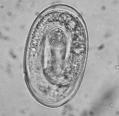Difference between revisions of "Dictyocaulus arnfieldi"
Jump to navigation
Jump to search
m (Text replace - "Category:To_Do_-_Max" to "") |
|||
| Line 43: | Line 43: | ||
[[Category:Dictyocaulus]][[Category:Horse_Nematodes]] | [[Category:Dictyocaulus]][[Category:Horse_Nematodes]] | ||
| − | + | ||
[[Category:Expert_Review]] | [[Category:Expert_Review]] | ||
[[Category:Respiratory Parasitic Infections]] | [[Category:Respiratory Parasitic Infections]] | ||
Revision as of 22:45, 9 October 2010
| This article has been peer reviewed but is awaiting expert review. If you would like to help with this, please see more information about expert reviewing. |
| Dictyocaulus arnfieldi | |
|---|---|
| Class | Nematoda |
| Super-family | Trichostrongyloidea |
| Genus | Dictyocaulus |
| Species | D. arnfieldi |
Also known as: Equine lungworm
Hosts
Donkeys, and occasionally horses.
Identification
D. arnfieldi are of the superfamily Trichostrongyloidea. Adults are slender, thread-like and white. Females are larger than males at around 6.5cm in length. The males have a small non-lobulated bursa.
The embryonated eggs are 80-100µm in length.
Life Cycle
The lifecycle is not greatly known, but it is currently thought to be similar to that of Dictyocaulus viviparus.
The prepatent period is 2-3 months.
Test yourself with the Horse Nematode Flashcards
Literature Search
Use these links to find recent scientific publications via CAB Abstracts (log in required unless accessing from a subscribing organisation).
Dictyocaulus arnfieldi publications

